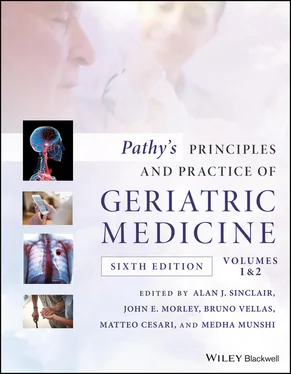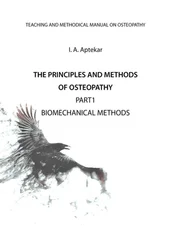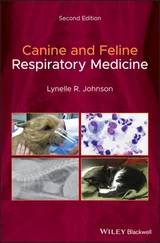Pathy's Principles and Practice of Geriatric Medicine
Здесь есть возможность читать онлайн «Pathy's Principles and Practice of Geriatric Medicine» — ознакомительный отрывок электронной книги совершенно бесплатно, а после прочтения отрывка купить полную версию. В некоторых случаях можно слушать аудио, скачать через торрент в формате fb2 и присутствует краткое содержание. Жанр: unrecognised, на английском языке. Описание произведения, (предисловие) а так же отзывы посетителей доступны на портале библиотеки ЛибКат.
- Название:Pathy's Principles and Practice of Geriatric Medicine
- Автор:
- Жанр:
- Год:неизвестен
- ISBN:нет данных
- Рейтинг книги:3 / 5. Голосов: 1
-
Избранное:Добавить в избранное
- Отзывы:
-
Ваша оценка:
- 60
- 1
- 2
- 3
- 4
- 5
Pathy's Principles and Practice of Geriatric Medicine: краткое содержание, описание и аннотация
Предлагаем к чтению аннотацию, описание, краткое содержание или предисловие (зависит от того, что написал сам автор книги «Pathy's Principles and Practice of Geriatric Medicine»). Если вы не нашли необходимую информацию о книге — напишите в комментариях, мы постараемся отыскать её.
Pathy’s Principles and Practice of Geriatric Medicine
Pathy's Principles and Practice of Geriatric Medicine — читать онлайн ознакомительный отрывок
Ниже представлен текст книги, разбитый по страницам. Система сохранения места последней прочитанной страницы, позволяет с удобством читать онлайн бесплатно книгу «Pathy's Principles and Practice of Geriatric Medicine», без необходимости каждый раз заново искать на чём Вы остановились. Поставьте закладку, и сможете в любой момент перейти на страницу, на которой закончили чтение.
Интервал:
Закладка:
Diagnostic criteria
The National Comprehensive Cancer Network recommended the following diagnostic criteria proposed by the International Working Group (IWG). 55Minimal diagnostic criteria for this disease include two prerequisites:
1 Stable cytopenia (for ≥6 months or ≥2 months if accompanied by a specific karyotype or bilineage dysplasia)
2 The exclusion of other potential disorders as a primary reason for dysplasia or cytopenia
In addition, the diagnosis of MDS requires ≥1 of three MDS‐related criteria:
1 Dysplasia (≥10% in ≥1 of the 3 major bone marrow lineages)
2 A blast cell count of 5% to 19%
3 A specific MDS‐associated karyotype (e.g. del(5q), del(20q), +8, or ‐7/del(7q))
Classification
A number of morphological classifications are in place to classify patients with MDS. The current term, MDS, was adopted by the French, American, and British (FAB) Cooperative Group in 1976 in their classification scheme of these disorders. The WHO classification was proposed as a modification of the FAB system 56and was revised in 2016 57from the previous version (2008) 58( Table 26.2).
Table 26.2 Classification scheme of myelodysplastic syndromes (MDS) in the 2016 revision of the World Health Organization (WHO) classification, and corresponding terminology in the 2008 WHO classification.
Source: Adapted from Sanz‐De Pedro et al. 46
| 2016 WHO classification | 2008 WHO classification |
|---|---|
| MDS with single‐lineage dysplasia | Refractory cytopenia with unilineage dysplasia |
| MDS with ring sideroblasts (MDS‐RS) MDS‐RS and single‐lineage dysplasia MDS‐RS and multilineage dysplasia | Refractory anaemia with ring sideroblasts |
| MDS with multilineage dysplasia | Refractory cytopenia with multilineage dysplasia |
| MDS with excess blasts‐1 | Refractory anaemia with excess blasts‐1 |
| MDS with excess blasts‐2 | Refractory anaemia with excess blasts‐2 |
| MDS, unclassifiable (MDS‐U) MDS‐U with 1% blood blasts MDS‐U with single‐lineage dysplasia and pancytopenia MDS‐U based on defining cytogenetic abnormality | MDS, unclassifiable (MDS‐U) |
| RCC (refractory cytopenia of childhood (provisional) | Childhood myelodysplastic syndrome (provisional) |
The 2016 WHO classification identifies six entities of MDS: MDS with single‐lineage dysplasia (MDS‐SLD), MDS with ring sideroblasts (MDS‐RS), MDS with multilineage dysplasia (MSD‐MLD), MDS with excess blasts (MDS‐EB), MDS with isolated del(5q), and MDS unclassifiable (MDS‐U). There is an additional provisional entity, ‘refractory cytopenia of childhood’ (RCC) ( Table 26.3).
Table 26.3 WHO 2016 classification.
Source: Adapted from Hong et al. 44
| Type | Dysplastic lineages | Cytopenia a | Ring sideroblasts in erythroid elements of BM | Blasts | Cytogenetics |
|---|---|---|---|---|---|
| MDS‐SLD | 1 | 1 or 2 | RS <15% (or <5% b) | PB <1% BM <5% No Auer rods | Any, unless fulfils criteria for isolated del(5q) |
| MDS‐MLD | 2 or 3 | 1–3 | RS <15% (or <5% b) | PB <1% BM <5% No Auer rods | Any, unless fulfils criteria for isolated del(5q) |
| MDS‐RS‐SLD: | 1 | 1 or 2 | RS ≱15% (or ≱5% b) | PB <1% BM <5% No Auer rods | Any, unless fulfils criteria for isolated del(5q |
| MDS‐RS‐MLD | 2 or 3 | 1–3 | RS ≱15% (or ≱5% b) | PB <1% BM <5% No Auer rods | Any, unless fulfils criteria for isolated del(5q |
| MDS with isolated del(5q) | 1–3 | 1–2 | None or any | PB <1% BM <5% No Auer rods | del(5q) alone or with one additional abnormality except ‐7 or del(7q) |
| MDS‐EB‐1 | 0–3 | 1–3 | None or any | PB 2~4% or BM 5~9%, No Auer rods | Any |
| MDS‐EB‐2 | 0–3 | 1–3 | None or any | PB 5~19% or BM 10%~19% or Auer | Any |
| MDS‐U with 1% peripheral blood blast | 1–3 | 1‐3 | None or any | PB=1% cBM<5% Auer rods | Any |
| MDS‐U with single‐lineage dysplasia and pancytopenia | 1 | 3 | None or any | PB <1% BM <5% No Auer rods | Any |
| Defining cytogenetic abnormality | 0 | 1–3 | <15% d | PB <1% BM <5% No Auer rods | MDS defining abnormality |
| RCC Refractory cytopenia of childhood | 1–3 | 1–3 | None | PB <2% BM <5% No Auer rods | Any |
WHO, World Health Organization; MDS, myelodysplastic syndromes; PB, peripheral blood; BM, bone marrow; RS, ring sideroblasts
aCytopenias MDS‐defining: Hb<100g/L, PLT<100×109/L, ANC<1.8×109/L; absolute monocytes count<1.0×109/L;
bwith SF3B1 mutation;
c1% PB blasts must be recorded on at least two separate observations;
dIf with ≥15% ring sideroblasts and significant erythroid dysplasia, and are classified as MDS‐RS‐SLD.
Table 26.4 Differential diagnosis of clonal or idiopathic cytopenias and myelodysplastic syndromes.
Source: Adapted from Montalban‐Bravo et al. 60
| Features | CHIP | ICUS | CCUS | MDS |
|---|---|---|---|---|
| Cytopenias | No | Yes (1 or more) | Yes (1 or more) | Yes (1 or more) |
| Dysplasia | No | None or minimal (non‐diagnostic for MDS) | None or minimal (non‐diagnostic for MDS) | Yes (>10% of elements per lineage in at least one |
| Somatic mutations | Yes, at a variant allele frequency ≥2%. Most commonly: DNMT3A, TET2, ASXL1, SRSF2, TP53 | No | Up to 36% overall with similar mutation VAF compared to MDS17% of ICUS without dysplasia45% of ICUS with some dysplasia | Up to 85% of patients |
| Risk of progression | Very low (0.5–1% per year) outside of therapy‐related setting | Up to 10% at five years | Up to 80% at five years but determined by mutational patterns |
CHIP, clonal hematopoiesis of indeterminate potential; ICUS, idiopathic cytopenia of undetermined significance; CCUS, clonal cytopenia of undetermined significance; MDS, myelodysplastic syndromes.
For MDS with ring sideroblasts, since the presence of the SF3B1 mutation is associated with the presence of RS, the updated WHO classification of MDS‐RS includes patients who have the SF3B1 mutation but lack excess blasts or an isolated del(5q) abnormality.
MDS with excess blasts is separated into patients with <10% marrow blasts (MDS‐EB‐1) and those with 10–19% marrow blasts (MDS‐EB‐2). It should also be noted that the denominator used for determining blast percentage in all myeloid neoplasms was redefined to include all nucleated bone marrow cells as opposed to only nonerythroid cells. This modification shifted a select group of patients previously categorized as AML to MDS‐EB.
MDS‐U (unclassifiable) is defined as the presence of 1% blasts in the peripheral blood, recorded on at least two separate occasions, with <5% BM blasts. MDS‐U also includes cases with single‐lineage dysplasia or isolated del(5q) and pancytopenia, or defining cytogenetic abnormality and one to three lineages cytopenia.
Uncertain conditions
Clonal somatic mutations involving MDS‐associated genes are detectable in individuals who otherwise do not meet the criteria for a definitive diagnosis of MDS or other myeloid neoplasms 46( Table 26.4). These mutations can be associated or not with cytopenias, and they can be associated with an increased risk of development of hematologic malignancies. 45The presence of such mutations without cytopenias or dysplasia has been called clonal hematopoiesis of indeterminate potential (CHIP) and is completely asymptomatic; cytopenia is associated with clonality in the absence of morphologic features of MDS is called clonal cytopenia of undetermined significance (CCUS).
Читать дальшеИнтервал:
Закладка:
Похожие книги на «Pathy's Principles and Practice of Geriatric Medicine»
Представляем Вашему вниманию похожие книги на «Pathy's Principles and Practice of Geriatric Medicine» списком для выбора. Мы отобрали схожую по названию и смыслу литературу в надежде предоставить читателям больше вариантов отыскать новые, интересные, ещё непрочитанные произведения.
Обсуждение, отзывы о книге «Pathy's Principles and Practice of Geriatric Medicine» и просто собственные мнения читателей. Оставьте ваши комментарии, напишите, что Вы думаете о произведении, его смысле или главных героях. Укажите что конкретно понравилось, а что нет, и почему Вы так считаете.












